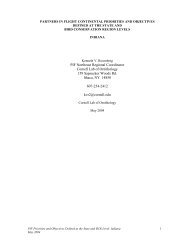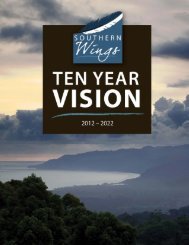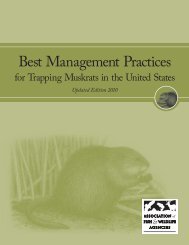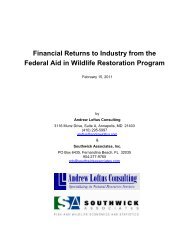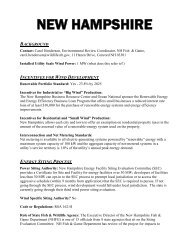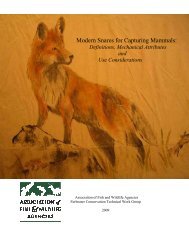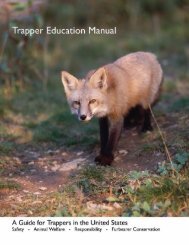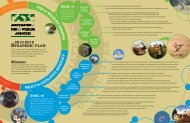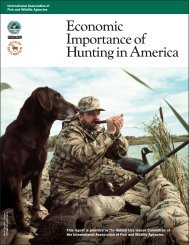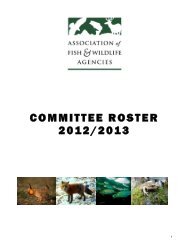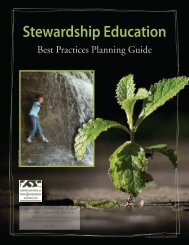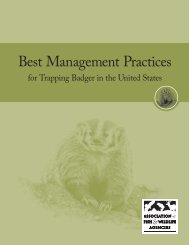2006 Annual Report - Association of Fish and Wildlife Agencies
2006 Annual Report - Association of Fish and Wildlife Agencies
2006 Annual Report - Association of Fish and Wildlife Agencies
Create successful ePaper yourself
Turn your PDF publications into a flip-book with our unique Google optimized e-Paper software.
About the <strong>Association</strong>A Year in Review: 2 0 0 6 A C C O M P L I S H M E N T SMarch 26: The <strong>Association</strong> holds the “Symposiumon Wind Energy Development <strong>and</strong> <strong>Wildlife</strong>.” Wind energyshows promise as a carbon free energy source. However,it is not without conflict as it leaves it’s footprint on wildlifehabitats. In order to encourage more engagement bywildlife agencies <strong>and</strong> non-government organizations,the <strong>Association</strong> held a symposium at the <strong>2006</strong> NorthAmerican <strong>Wildlife</strong> <strong>and</strong> Natural Resources Conferencein Columbus, Ohio.The Symposium provided a much needed first steptowards a better underst<strong>and</strong>ing <strong>of</strong> the current state <strong>of</strong>wind energy technology, the sequential steps typicallyimplemented during development, <strong>and</strong> the best availablewildlife science related to wind power. The Symposium waswell attended, with st<strong>and</strong>ing room only, <strong>and</strong> well receivedas a source <strong>of</strong> much needed information.July 8: The <strong>Association</strong>sends five staterepresentatives to Peruto work with the U.S. <strong>Fish</strong><strong>and</strong> <strong>Wildlife</strong> Service onConvention on InternationalTrade in EndangeredSpecies <strong>of</strong> Wild Fauna <strong>and</strong>Flora (CITES) conservationcommittees.Sept. 18: <strong>Association</strong> holds a nationalcommunications workshop “Wild Encounters:Turning <strong>Wildlife</strong> Conflict Into Winning MediaCoverage” to provide tools for talking to themedia about human/wildlife interface.• The <strong>Association</strong> intervenes in federal court on national <strong>and</strong>regional fish <strong>and</strong> wildlife issues affecting its membership.• <strong>Association</strong> members <strong>and</strong> staff participate in advising<strong>and</strong> testifying on Capitol Hill <strong>and</strong> in developing coalitionsto support needed conservation legislation.• The <strong>Association</strong> participates in developing internationaltreaties, laws, regulations <strong>and</strong> policies concerning thewelfare <strong>of</strong> North America’s fish <strong>and</strong> wildlife.• The <strong>Association</strong> works across the international boundaries<strong>of</strong> Canada <strong>and</strong> Mexico to help coordinate border-state fish<strong>and</strong> wildlife management.• The <strong>Association</strong> works with members <strong>and</strong> partnersto develop <strong>and</strong> implement programs for conservation,education <strong>and</strong> fish <strong>and</strong> wildlife recreation.• The <strong>Association</strong> leads the “Teaming with <strong>Wildlife</strong>” Coalition<strong>of</strong> more than 5,000 organizations to exp<strong>and</strong> on funding toprevent fish <strong>and</strong> wildlife from becoming endangered.Jan. 31: Under Sikes Act,the <strong>Association</strong> signs a jointagreement with the U.S.<strong>Fish</strong> <strong>and</strong> <strong>Wildlife</strong> Service <strong>and</strong>the Department <strong>of</strong> Defenseto better manage wildlife onmilitary installations.March 1: Teaming with<strong>Wildlife</strong> launches a newthree-year campaign t<strong>of</strong>ind greater funding forwildlife conservation.May 1: The <strong>Association</strong>introduces its newname, website, logo <strong>and</strong>outreach materials.Sept. 17: <strong>Association</strong>holds its 96th <strong>Annual</strong>Meeting in Snowmass,Colorado with a record740 attendees.Sept. 20: The<strong>Association</strong> hosts anational workshop to helpstate agencies find waysto find funding for theirstate wildlife action plans.Nov. 7: The <strong>Association</strong>, as part<strong>of</strong> the Natural Resources MonitoringPartnership, launches a new hightechdatabase <strong>and</strong> mapping systemfor comprehensive monitoring.JANUARY FEBRUARY MARCH APRIL MAY JUNE JULY AUGUST SEPTEMBER OCTOBER NOVEMBER DECEMBERMarch 7: The <strong>Association</strong>launches new national“Trapping Best ManagementPractice Guides.May 4: Teaming with<strong>Wildlife</strong> submits bipartisanletter with signatures from anunprecedented 170 Houserepresentatives <strong>and</strong> 56senators urging an increasein funding for the State<strong>Wildlife</strong> Grants Program.Sept. 17: The<strong>Association</strong> hostsfirst ever nationalworkshop on DeerImmunocontraception,a forum <strong>of</strong> federal <strong>and</strong>state dialogue.Nov. 3: The <strong>Association</strong>helps launch the first class<strong>of</strong> the National ConservationLeadership Institute,preparing 36 future leadersto cope with growing fish<strong>and</strong> wildlife challenges.Dec. 29: The <strong>Association</strong> celebrates the reauthorization <strong>of</strong> theMagnuson-Stevens <strong>Fish</strong>eries Conservation <strong>and</strong> Management Act.Jan. 13: The <strong>Association</strong> submitsa brief to the Supreme Court arguingto uphold Clean Water Act protection<strong>of</strong> headwater wetl<strong>and</strong>s <strong>and</strong> streams.April 24: The <strong>Association</strong>helps launch the National<strong>Fish</strong> Habitat Action Plan,a l<strong>and</strong>scape-scale effortto conserve <strong>and</strong> enhancethe nation’s waterways.June 30: The<strong>Association</strong> names formerActing Assistant Secretary<strong>of</strong> the Department <strong>of</strong>Interior, Matt Hogan, as thenew executive director.July 31: <strong>Association</strong> pastPresident, John Cooper <strong>and</strong>current President, Ed Parkernamed two <strong>of</strong> 20 national boardmembers to guide the National<strong>Fish</strong> Habitat Action Plan.The <strong>Association</strong> <strong>of</strong> <strong>Fish</strong> <strong>and</strong> <strong>Wildlife</strong> <strong>Agencies</strong> applauded thePresident’s signing <strong>of</strong> the reauthorization <strong>of</strong> the nation’s primarymarine fisheries law, the Magnuson-Stevens <strong>Fish</strong>eries Conservation<strong>and</strong> Management Reauthorization Act <strong>of</strong> <strong>2006</strong>. The <strong>Association</strong>’smember agencies <strong>and</strong> partners have waited 10 years for thereauthorization, <strong>and</strong> expect that this new legislation will play animportant role in helping sustain a diverse array <strong>of</strong> marine life <strong>and</strong>their habitats, while allowing continued sustainable use <strong>of</strong> valuableaquatic resources. Throughout this reauthorization, the <strong>Association</strong>has been impressed by the work <strong>of</strong> numerous lawmakers committedto improving the science-based management <strong>of</strong> our Nation’s marinefisheries. We also recognize particularly their strong interests inpromoting more effective implementation <strong>and</strong> enforcement <strong>of</strong> fisherymanagement plans.The act was actually signed into law in January <strong>of</strong> 2007, but had beendeveloped through the work <strong>of</strong> the 109th Congress.The <strong>Association</strong>, <strong>and</strong> the state fish <strong>and</strong> wildlife agencies it represents,are part <strong>of</strong> a coalition facilitated by the Theodore RooseveltConservation Partnership (TRCP) that represents recreational anglers,the sportfishing industry <strong>and</strong> conservation groups to establish the“SALT Principles,” (Science, Allocation, Licensing <strong>and</strong> Tackle) whichoutlined consensus-based recommendations for addressing marinefishery problems <strong>and</strong> opportunities. For additional information aboutthe SALT Principles, go to: www.angling4oceans.org.8 <strong>Association</strong> <strong>of</strong> <strong>Fish</strong> & <strong>Wildlife</strong> <strong>Agencies</strong> 2 0 0 6 A N N U A L R E P O R T <strong>Association</strong> <strong>of</strong> <strong>Fish</strong> & <strong>Wildlife</strong> <strong>Agencies</strong> 2 0 0 6 A N N U A L R E P O R T 9
Education, Outreach<strong>and</strong> StewardshipConservation Education StrategyConservation education is one <strong>of</strong> the most vital toolsfor shaping long-term conservation <strong>and</strong> enjoyment <strong>of</strong>fish <strong>and</strong> wildlife resources. The <strong>Association</strong>’s members<strong>of</strong>fer a variety <strong>of</strong> programs to educate children <strong>and</strong>adults about the conservation <strong>of</strong> fish, wildlife <strong>and</strong> othernatural resources, but until recently, there was no onenational strategy for conservation education. In 2005,the <strong>Association</strong> decided to strengthen <strong>and</strong> unify theconservation education efforts <strong>of</strong> its member agencies<strong>and</strong> partners <strong>and</strong> in March 2005, approved the<strong>Association</strong>’s North American Conservation EducationStrategy. Now that the Strategy is well underway,the <strong>Association</strong> is shifting to supporting effectiveimplementation <strong>and</strong> turning the strategic visioninto action.In <strong>2006</strong>, the <strong>Association</strong> received a three-year MultistateConservation Grant to help implement the Strategy, ledby the Conservation Education Working Group. Theresult <strong>of</strong> this project will be to implement the Strategy<strong>and</strong> work to unify <strong>and</strong> strengthen conservation educationefforts <strong>of</strong> the <strong>Association</strong>’s member agencies <strong>and</strong> partners.Trapping Best Management PracticesAs wildlife management agencies across the nationcontinue to face challenges with managing furbearerspecies, it is critical that they have the best informationon trapping, allowing them to maintain regulatedtrapping as a viable wildlife management tool. Tosupport this need, in <strong>2006</strong> the <strong>Association</strong> introducedeight new Trapping Best Management Practiceeducation guides that focus on animal welfare,efficiency, selectivity, practicality <strong>and</strong> safety.Based on the most extensive study <strong>of</strong> animal trapsever conducted in the United States, Trapping BestManagement Practices (BMPs) are based on scientificresearch <strong>and</strong> pr<strong>of</strong>essional experience <strong>of</strong> currentlyavailable trap technology. They provide options tosupport trapper discretion <strong>and</strong> decision-making inthe field <strong>and</strong> provide the infrastructure <strong>and</strong> criteriato improve trapping methods in the future.The <strong>Association</strong> plans to release four new BMPs in 2007.The BMP educational guides can be found online atwww.fishwildlife.org under the Programs section.Developing Tomorrow’s LeadersAccording to recent research, about 77 percent <strong>of</strong> statefish <strong>and</strong> wildlife agency senior leadership will retirebetween 2004 <strong>and</strong> 2015, but the nation’s conservationorganizations—including the <strong>Association</strong> <strong>of</strong> <strong>Fish</strong><strong>and</strong> <strong>Wildlife</strong> <strong>Agencies</strong>—are not waiting around t<strong>of</strong>ind out what happens when they leave. In <strong>2006</strong>, 36<strong>of</strong> the nation’s future natural resource conservation“future leaders” were selected for the first fellowships“ Seventy-five percent <strong>of</strong>today’s fish <strong>and</strong> wildlifeleaders will retire in thenext 10 years. We haveto prepare for this changeproactively, by trainingtomorrow’s leaders today.”— Ken Haddadd, Executive DirectorFlorida <strong>Fish</strong> <strong>and</strong> <strong>Wildlife</strong>Conservation Commission<strong>of</strong> the National Conservation Leadership Institute.The National Conservation Leadership Institute wascreated to train tomorrow’s conservation leaders in thelatest leadership thinking <strong>and</strong> practice, <strong>and</strong> each Fellowlearned from the nation’s most influential conservationleaders <strong>and</strong> leadership experts including Marty Linsky,co-author <strong>of</strong> the book, Leadership on the Line.Offered each year to a select group <strong>of</strong> individuals identifiedas “high potentials”, the Institute is by no means only atraining program; it is a unique comprehensive learningexperience designed to challenge assumptions, teachskills, facilitate networking, <strong>and</strong> strengthen confidence,preparing extraordinary leadership for the future.Each Fellow was chosen for potential to build effectivecoalitions, lead organizational change, <strong>and</strong> deliverresults as well as for their work experience <strong>and</strong> goals.This year, the Institute trained 22 state fish <strong>and</strong> wildlifeemployees, six federal conservation agency employees,two tribal members, three industry employees <strong>and</strong> threenon-governmental agency employees during a 10-monthperiod on priority leadership challenges <strong>and</strong> solutions.The <strong>Association</strong> played a lead role in realizing this effort.Developing leadership in our agencies requires adifferent approach to meeting the many challenges<strong>of</strong> the state fish <strong>and</strong> wildlife agencies. Developing isbuilding, <strong>and</strong> building takes tools. The <strong>Association</strong>’sManagement Assistance Team (MAT) has providedthe tools in the form <strong>of</strong> leadership courses <strong>and</strong> manyresources. Some employees are taking one or more <strong>of</strong>the six online leadership courses in virtual classroomswith employees from other state fish <strong>and</strong> wildlifeagencies. Each state uses these tools in different ways.Other tools available to states are the nine face-to-facecourses. Some states are taking advantage <strong>of</strong> the toolbox’sconsulting services or other expertise on leadershipdevelopment <strong>and</strong> workforce succession planning.In 2007, MAT will continue to work with many stateagencies on leadership development <strong>and</strong> successionplanning.Recognizing Our MembersEach year, many fish <strong>and</strong> wildlife agencies, organizations <strong>and</strong> individuals partner with the <strong>Association</strong><strong>of</strong> <strong>Fish</strong> <strong>and</strong> <strong>Wildlife</strong> <strong>Agencies</strong> to help fulfill its mission to be the “voice <strong>of</strong> fish <strong>and</strong> wildlife agencies.”The <strong>Association</strong> benefits greatly from these relationships, making it possible for the <strong>Association</strong> t<strong>of</strong>ocus on finding new ways to strengthen conservation <strong>and</strong> wildlife management initiatives.State <strong>Fish</strong> <strong>and</strong> <strong>Wildlife</strong> Agency MembersAlabama Division <strong>of</strong> <strong>Wildlife</strong> & Freshwater <strong>Fish</strong>eriesAlaska Department <strong>of</strong> <strong>Fish</strong> <strong>and</strong> GameArizona Game <strong>and</strong> <strong>Fish</strong> DepartmentArkansas Game <strong>and</strong> <strong>Fish</strong> CommissionCalifornia Department <strong>of</strong> <strong>Fish</strong> <strong>and</strong> GameColorado Division <strong>of</strong> <strong>Wildlife</strong>Connecticut Department <strong>of</strong> Environmental ProtectionDelaware Division <strong>of</strong> <strong>Fish</strong> <strong>and</strong> <strong>Wildlife</strong>Florida <strong>Fish</strong> <strong>and</strong> <strong>Wildlife</strong> Conservation CommissionGeorgia <strong>Wildlife</strong> Resources DivisionHawaii Department <strong>of</strong> L<strong>and</strong> <strong>and</strong> Natural ResourcesIdaho <strong>Fish</strong> <strong>and</strong> Game DepartmentIllinois Department <strong>of</strong> Natural ResourcesIndiana Department <strong>of</strong> Natural ResourcesIowa Department <strong>of</strong> Natural ResourcesKansas Department <strong>of</strong> <strong>Wildlife</strong> <strong>and</strong> ParksKentucky Department <strong>of</strong> <strong>Fish</strong> <strong>and</strong> <strong>Wildlife</strong> ResourcesLouisiana Department <strong>of</strong> <strong>Wildlife</strong> <strong>and</strong> <strong>Fish</strong>eriesMaine Department <strong>of</strong> Inl<strong>and</strong> <strong>Fish</strong>eries & <strong>Wildlife</strong>Maryl<strong>and</strong> Department <strong>of</strong> Natural ResourcesMassachusetts Division <strong>of</strong> <strong>Fish</strong>eries <strong>and</strong> <strong>Wildlife</strong>Michigan Department <strong>of</strong> Natural ResourcesMinnesota Department <strong>of</strong> Natural ResourcesMississippi Department <strong>of</strong> <strong>Wildlife</strong>, <strong>Fish</strong>eries & ParksMissouri Department <strong>of</strong> ConservationMontana Department <strong>of</strong> <strong>Fish</strong>, <strong>Wildlife</strong> & ParksNebraska Game <strong>and</strong> Parks CommissionNevada Department <strong>of</strong> <strong>Wildlife</strong>New Hampshire <strong>Fish</strong> <strong>and</strong> Game DepartmentNew Jersey Division <strong>of</strong> <strong>Fish</strong> <strong>and</strong> <strong>Wildlife</strong>New Mexico Game <strong>and</strong> <strong>Fish</strong> DepartmentNew York Division <strong>of</strong> <strong>Fish</strong>, <strong>Wildlife</strong> <strong>and</strong> Marine ResourcesNorth Carolina <strong>Wildlife</strong> Resources CommissionNorth Dakota Game <strong>and</strong> <strong>Fish</strong> DepartmentOhio Division <strong>of</strong> <strong>Wildlife</strong>Oklahoma Department <strong>of</strong> <strong>Wildlife</strong> ConservationOregon Department <strong>of</strong> <strong>Fish</strong> <strong>and</strong> <strong>Wildlife</strong>Pennsylvania <strong>Fish</strong> <strong>and</strong> Boat CommissionPennsylvania Game CommissionRhode Isl<strong>and</strong> Division <strong>of</strong> <strong>Fish</strong> <strong>and</strong> <strong>Wildlife</strong>South Carolina Department <strong>of</strong> Natural ResourcesSouth Dakota Game, <strong>Fish</strong> & Parks DepartmentTennessee <strong>Wildlife</strong> Resources AgencyTexas Parks <strong>and</strong> <strong>Wildlife</strong> DepartmentUtah Division <strong>of</strong> <strong>Wildlife</strong> ResourcesVermont Department <strong>of</strong> <strong>Fish</strong> <strong>and</strong> <strong>Wildlife</strong>Virginia Department <strong>of</strong> Game & Inl<strong>and</strong> <strong>Fish</strong>eriesWashington Department <strong>of</strong> <strong>Fish</strong> <strong>and</strong> <strong>Wildlife</strong>West Virginia Division <strong>of</strong> Natural ResourcesWisconsin Department <strong>of</strong> Natural ResourcesWyoming Game <strong>and</strong> <strong>Fish</strong> DepartmentSuccess StoriesAre You AWARE?America’s <strong>Wildlife</strong> <strong>Association</strong> for ResourceEducation (AWARE) is the 501-(c)3 foundation<strong>of</strong> the <strong>Association</strong> <strong>of</strong> <strong>Fish</strong> <strong>and</strong> <strong>Wildlife</strong> <strong>Agencies</strong>.A hundred percent <strong>of</strong> all contributions to theAWARE Foundation go toward ensuring thateducation will help carry the good work <strong>of</strong> theconservation community for generations tocome.Some programs supported in part by AWAREinclude, the North American ConservationEducation Strategy, Teaming with <strong>Wildlife</strong> <strong>and</strong>an annual small grants program for the states.12 <strong>Association</strong> <strong>of</strong> <strong>Fish</strong> & <strong>Wildlife</strong> <strong>Agencies</strong> 2 0 0 6 A N N U A L R E P O R T <strong>Association</strong> <strong>of</strong> <strong>Fish</strong> & <strong>Wildlife</strong> <strong>Agencies</strong> 2 0 0 6 A N N U A L R E P O R T 13
Executive Director<strong>and</strong> StaffChanging Face <strong>of</strong> ConservationIn August <strong>of</strong> <strong>2006</strong>, the <strong>Association</strong> <strong>of</strong> <strong>Fish</strong> <strong>and</strong> <strong>Wildlife</strong><strong>Agencies</strong> named Matt Hogan the new ExecutiveDirector. Prior to his work with the <strong>Association</strong>, Hoganwas the Acting Assistant Secretary <strong>of</strong> the Department<strong>of</strong> the Interior for <strong>Fish</strong> <strong>and</strong> <strong>Wildlife</strong> <strong>and</strong> Parks.“It is a great honor to accept this position. The <strong>Association</strong><strong>of</strong> <strong>Fish</strong> <strong>and</strong> <strong>Wildlife</strong> <strong>Agencies</strong> is one <strong>of</strong> our country’smost successful wildlife conservation organizations. I lookforward to working with North America’s fish <strong>and</strong> wildlifeagencies, conservation partners, <strong>and</strong> an incredible staffin continuing the <strong>Association</strong>’s outst<strong>and</strong>ing tradition,”said Hogan.For more than a month, Hogan worked alongsidethe then Executive Vice President, John Baughman.Baughman left the <strong>Association</strong> to return to hishome state <strong>of</strong> Wyoming on September 27.“Having worked with Matt, I know his policy <strong>and</strong>leadership experience, skills, <strong>and</strong> his knowledge <strong>of</strong> fish<strong>and</strong> wildlife issues will be an asset,” said John Cooper,Cabinet Secretary <strong>of</strong> South Dakota Game, <strong>Fish</strong>, <strong>and</strong> ParksDepartment <strong>and</strong> the former President <strong>of</strong> the <strong>Association</strong><strong>of</strong> <strong>Fish</strong> <strong>and</strong> <strong>Wildlife</strong> <strong>Agencies</strong>. “John Baughman hasraised the bar, <strong>and</strong> when he leaves, it will be challengingto fill his shoes. However, Matt’s long-term interest in the<strong>Association</strong>, <strong>and</strong> his ties with many <strong>of</strong> its members willbe his strong suit.”StaffHogan has more than 18 years working in wildlifemanagement <strong>and</strong> conservation in the Washington, D.C.policy arena. In the last four years, he held key leadershiproles for both the U.S. <strong>Fish</strong> <strong>and</strong> <strong>Wildlife</strong> Service (USFWS)<strong>and</strong> U.S. Department <strong>of</strong> the Interior. As Acting AssistantSecretary <strong>of</strong> Interior he oversaw both the USFWS <strong>and</strong>National Parks Service. He previously served as ActingDirector <strong>and</strong> as Deputy Director <strong>of</strong> the USFWS.Committees, Subcommittees <strong>and</strong> Working GroupsThe <strong>Association</strong> maintains more than 60 nationalcommittees, working groups <strong>and</strong> subcommittees composed<strong>of</strong> more than a thous<strong>and</strong> pr<strong>of</strong>essionals from the UnitedStates, Canada <strong>and</strong> Mexico. Each committee is led by statefish <strong>and</strong> wildlife agency leaders, <strong>and</strong> is <strong>of</strong>ten responsible forthe creation <strong>of</strong> important national conservation action.The <strong>Association</strong>’s committees meet for one week twice ayear (March <strong>and</strong> September), where they share information,Agricultural ConservationAngler/Boating Participation<strong>Annual</strong> Meeting/Awards/Nominating<strong>Association</strong> BudgetAuditBird ConservationEducation/Outreach/DiversityEnergy & <strong>Wildlife</strong> PolicyFederal & Tribal Relations<strong>Fish</strong> & <strong>Wildlife</strong> Health<strong>Fish</strong> & <strong>Wildlife</strong> Trust Funds<strong>Fish</strong>eries/Water Resources PolicyHunting/Shooting Sports ParticipationInternational RelationsInvasive SpeciesLaw EnforcementLeadership/Pr<strong>of</strong>essional DevelopmentLegalLegislative/Federal BudgetNational GrantsResolutionsScience <strong>and</strong> ResearchStrategic IssuesSustainable <strong>Wildlife</strong> UseTeaming with <strong>Wildlife</strong>Technologies & Data UtilizationThreatened/Endangered Species Policy<strong>Wildlife</strong> Resource PolicyAquaculture Drug ApprovalBi<strong>of</strong>uelsCITES TechnicalClimate ChangeCoal, Oil <strong>and</strong> S<strong>and</strong>sCommodityConservation ComplianceConservation Reserve ProgramConservation Securities ProgramDove/Lead ToxicosisEnvironmental Quality IncentivesFederal Aid Joint Task ForceForestryField Office Techincal GuideFarm <strong>and</strong> Ranchl<strong>and</strong> ProtectionProgramprovide updates <strong>and</strong> decide their goals for the year. At theend, each committee chair gives a brief report <strong>of</strong> actions tothe entire membership during the <strong>Association</strong>’s BusinessMeeting. In turn, this affects the <strong>Association</strong>’s StrategicPlan <strong>and</strong> influences the collective statefish <strong>and</strong> wildlife agency agenda.Grassl<strong>and</strong> Reseve ProgramHuman <strong>and</strong> <strong>Wildlife</strong> ConflictL<strong>and</strong>owner Incentive ProgramMigratory Shore <strong>and</strong> Upl<strong>and</strong>GamebirdNational Flyway CouncilNational <strong>Fish</strong> Habitat BoardNon-toxic AmmunitionOffshore Gas <strong>and</strong> OilOnshore Gas <strong>and</strong> OilPresident’s Committee on CleanWater Act JurisdictionsPartners in Flight/ Shorebird/WaterbirdPublic AccessResident Game BirdTransmission CorridorsTechnical Service ProviderWaterfowl<strong>Wildlife</strong> Habitat Incentives ProgramWind PowerWetl<strong>and</strong>s Reserve ProgramCarol Bambery<strong>Association</strong> CounselRachel BrittinPublic Affairs DirectorRebecca BrookeTeaming with <strong>Wildlife</strong>Communications <strong>and</strong>Coalition AssociateDave ChadwickTeaming with <strong>Wildlife</strong><strong>Wildlife</strong> Diversity SeniorAssociateNaomi EdelsonTeaming with <strong>Wildlife</strong> &<strong>Wildlife</strong> Diversity DirectorJake FaibischManagement Assistance TeamProject LeaderEstelle GreenAdministrative AssistantDebbie HahnMigratory Bird CoordinatorJeff JohnstonAWDS Coordinator/WebmasterDon MacLauchlanInternational Resource DirectorGina MainManagement Assistance TeamGraphics/Production CoordinatorWendy MansfieldChief Financial OfficerMelissa McCormickManagement Assistance TeamProject CoordinatorJennifer MockFarm Bill CoordinatorAngela Rivas NelsonExecutive AssistantAmber PairisScience <strong>and</strong> Research LiaisonDonna ReeveManagement Assistance TeamAdministration AssistantSean RobertsonTeaming with <strong>Wildlife</strong>Communications <strong>and</strong>Coalition AssociateEric SchwaabResource DirectorLiz SkipperAdministrative AssistantGary TaylorLegislative DirectorLen UgarenkoNorth American WaterfowlManagement Plan CoordinatorBryant WhiteFurbearer Research CoordinatorChristina ZarrellaMultistate Grants Coordinator“ As chair <strong>of</strong> the AgriculturalConservation Committee, I consultwith dozens <strong>of</strong> other fish <strong>and</strong>wildlife leaders to ensure that mystate has the best science-basedknowledge, practices <strong>and</strong> tools totake action at home.”— Jeff Vonk, Secretary <strong>of</strong> South Dakota Game,<strong>Fish</strong> <strong>and</strong> Parks Department16 <strong>Association</strong> <strong>of</strong> <strong>Fish</strong> & <strong>Wildlife</strong> <strong>Agencies</strong> 2 0 0 6 A N N U A L R E P O R T



